Your music scheduling strategies & tactics should always be based on regular market research & analysis, music programming expert Robert Johansson of Better Radio advises.
Before you set up or optimize your station’s music categories, format clocks, song rotations, artist separations, sound codes and station images, monitor what you (and your competitors) are doing on a regular basis. “We could spot that they were moving in a certain direction earlier than we could have done otherwise.” [See also part 1 and part 2 of this interview]
“Get a bigger variety”
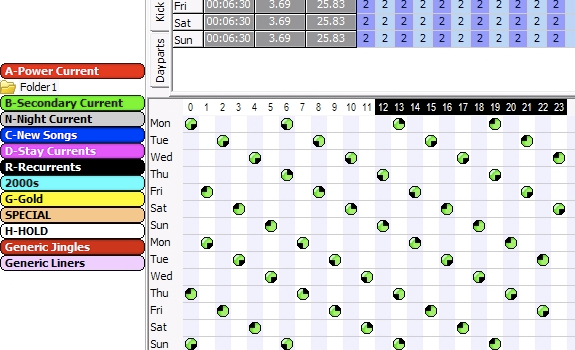
Using multiple format clocks helps to spread songs in small categories over all 4 quarter hours (image: Powergold)
Have one category theme
What’s a good default song category setup for music scheduling?
“If you have a short list of music categories, they tend to be big – so it’s hard to define what each category is really about. Some stations have 1 or 2 categories, and many rules to make the list pretty good. But it’s impossible to get an even exposure in such a setup. On the other hand: if you have many categories, you need more different clocks to expose songs in multiple quarter hours.” Johansson thinks that around 10 music categories would still be okay. His setup for a Hot AC station looks like this:
- Power currents
- Secondary currents
- Stay currents
- New music
- Image songs
- Power recurrents
- Secondary recurrents
- Power classics (1 or 2 categories)
- Secondary classics (1 or 2 categories)
(Image songs are new titles that would only play at evening and night; not during daytime.)
 Rotate songs through quarters
Rotate songs through quarters
How many format clocks should you have, and what do you think of rotating them?
“I’m a big fan of that. The number of A songs defines the number of clocks. If I’m playing 3 A songs – like one each hour – I prefer to have 4 different clocks. Then I can let each A song play in the first, second, third and fourth quarter before it comes back in the same quarter.”
Avoid music category synchronization
Other programmers might say: I want an A current in every quarter hour. So for a good song rotation, they’d need a power current category of at least 5 titles. What do you think of that?
“It’s depending on the format. But I would rather say: one current power song in the hour is an A current; another current power song in the hour is a stay current, and so on. By having different categories in these clocks, you can get a bigger variety, because you don’t play categories close to each other. I like to create patterns where you have different category turnovers: one category rotating in 3 hours; a second one in 5 hours; a third one in 7 hours. Based on mathematical rotations, it will take forever before the same songs from those categories all end up in the same hour together again.”
“You could afford to
lose some listeners”

Research might indicate that focusing on a certain (part of your) audience has more potential (photo: She Knows)
Prepare different clock grids
Does it mean that you always need a fixed number of songs per current music category?
“I have worked with a station where we built different matrixes. We prepared a second one which included different format clocks, and depending on how many suitable currents we had available, we’d switch the clock matrix. It’s not very common. Usually, if you don’t have enough songs, you’ll move one of your stay currents or power recurrents into one of these slots. But they wanted the ability to change the patterns, and by having these two different sets it was quite easy for them.”
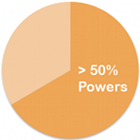 Increase top song exposure
Increase top song exposure
If you program a music station and your ratings go down, what can you do with your music to fix it?
“It’s hard to say why numbers go down, but yes, music is usually the problem. One solution is to play more powers”, he advises, adding that a market study is usually the very best way to go, because in the end it’s all about doing the right format.
Choose the right strategy
“You could do research and see, for example, that one part of your audience loves newer music, while the other part loves older music. So if you become more contemporary, you’ll lose some older listeners – and if you stick to the old stuff, you won’t get fans of new songs. But in research you might also see that the future with one of these groups is brighter, because the competition from other stations is not so big there. In that sense, you could afford to lose some listeners. But you really need to check that with research.”
“It’s all about:
who are your core artists?”

Listeners of a CHR station in 2014 might expect to hear more Avicii than Madonna songs (photos: Flickr, Mixmag)
Check high-rotation category positions
How do you keep artists who have many hits (or connections to other current hit songs) separated without messing up your natural rotations?
“I try to schedule the must-play songs quite mathematical, and run some analysis tools to check what kind of minimum separations I have between these songs. Usually, only 3 or 4 hours have problems, in which case I make necessary playlist changes manually. Then, there are other artists where you can have a discussion about whether you need to separate them, like David Guetta or Avicii who are all using different voices. Do you really need to separate these songs?”
 Separate similar music genres
Separate similar music genres
Maybe for sound codes?
“Yes, but that’s another thing. In terms of sound separation, I would not play two Avicii songs back to back, of course – unless I do a ‘double play’, if I have a presenter who’s selling it. But in general, it comes down to listen to each and every song and think about which codes are really important for us? Most music directors like to separate the songs more than they need.”
Use format-confirming artist separations
What about using a Special Artist Separation for all Aviciis of this world?
“I’m a big fan of using them, but you should ask yourself how well-expected this song is on the station. If you’re a CHR and spin 2 Avicii songs in an hour, it’s according to listener expectations. On the other hand: playing Madonna with a 1-hour separation would be a bigger ‘no’ than playing two Avicii songs within 40 minutes, on this station. So it’s all about: who are your core artists? And even if you spin the same artist within one hour, how many listeners will hear both songs?”
“The thing that makes the difference is
how you package it”
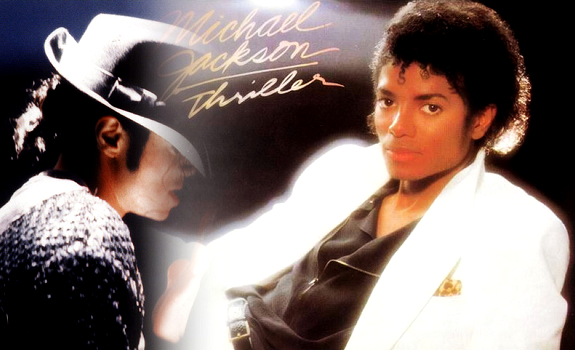
Specialty programming around specific themes is about more than just playing (some) songs (image: HOT 104.1)
Listen different than audience
Indeed, people don’t listen linear, but in short increments, as they tune in & out many times.
“It comes back to the strength of radio; companionship wherever you are, while you can do something else at the same time. If you watch a movie on TV, you actually watch that – maybe not as focused as you did 3 or 4 years ago. But for radio, it’s a common thing that you listen to the it while the phone rings or while you grab something in the fridge. You and me listen to radio very intense, like how was this segue; what kind of song started playing; what are they talking about? As you said in the beginning, you noticed a CHR station where one hour was very rhythmic and another hour was very much ‘Pop-Rock’. But will a regular listener wonder about ‘two different stations’ on one station? If somebody would call and ask them ‘what station have you been listening to?’, they probably wouldn’t know.”
 Maintain good era balance
Maintain good era balance
But in a diary market, could a competitor with a strong Pop-Rock image get that station in trouble over time?
“Definitely”, he says about the need to have a consistent sound. “I listened to an Oldies station in the car, on the way to a meeting, and heard the newer part of their format. One hour later, after my meeting, they mainly played the older part of the format. It was still daytime programming, so not a specialty show.”
Make small promotions bigger
Speaking of specialty shows, how do you deal with programming around a certain artist or genre, like a Michael Jackson Weekend, versus your normal song rotations?
“I usually play the same number of power songs in each hour, and replace secondary songs with theme songs. But when it comes to theme weekends, the thing that makes the difference is how you package it.” He recalls a US client who did a specialty weekend – while playing just one song an hour. “They put it on their site; posted it on Facebook; had presenters talking about it; did contests; played promos. That could be enough; you don’t need to do much more.”
“Draw the line”
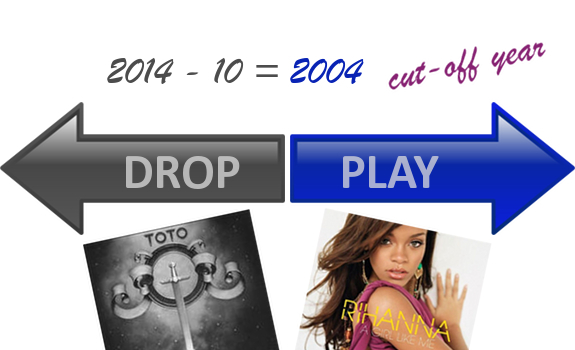
Your music library should have a clear cut-off date in terms of how far you go back in history (image: Thomas Giger)
Monitor your station & competition
Do you also do format analyses, where you track what stations are playing by the minute?
“One of my recommendations is to do a regular music monitor, where you write down every song’s artist, title, sound, tempo and era. For clients, we track the own station and 3 to 4 main competitors once every 4 months. When you do a competition analysis, make a note whenever a song is played by you (or could be played by you) so you’ll see if and how much you’re different.” He advises to also keep track of the number of new songs, and the shortest rotations in between the songs.
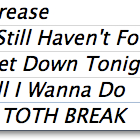 Archive your (competition) trackings
Archive your (competition) trackings
Doing regular music monitors (and looking for larger trends) can pay off. “We keep everything a spreadsheet to monitor if a competing station is changing its format. For one client, I have an Excel sheet with results that are going back 4 years. Recently we noticed that one of our competitors had changed. We could really spot that they were moving in a certain direction earlier than we could have done otherwise.”
“Monitor if a competing station is changing its format”
Define your ground zero
There’s an interesting phenomenon that 80s music is still very popular. But these songs may also give younger listeners the image of being ‘the station for my parents’ :-).
“Yeah. I have one client who doesn’t play 80s at all. We did a music study, and afterwards they decided: we never go more than 10 years back; that’s where we draw the line. For them, it was a good decision. They really are the station that’s more contemporary than the competition. They don’t play just new music; they have a huge base of stay currents and power recurrents. The station is doing quite well in the ratings.”
“I’m a pretty big fan of
LA radio”

Top stations in Los Angeles are often well scheduled (logos: CBS Radio, Clear Channel / photo: National Geographic)
Optimize your automation workflow
What do you see as the future of music scheduling?
“Absolute Radio’s differentiated playlist choice at breakfast is pretty cool! But you’ll lose some control when it comes to music balance, because you need to check if songs are evenly timed. On their 60s station, they could play two songs back-to-back [as these usually take half of the time of songs in later decades] and they’ll probably edit songs into different lengths. It’s an excellent thing to do. I’ve been in a situation where we discussed to get more voice tracking done on a day, and record generic voice tracks which you can use for different music sweeps, or even use on several different channels. In addition, you can do 2 or 3 specific breaks an hour. It’s possible with today’s equipment.”
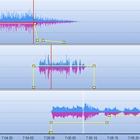 Spend your budget wisely
Spend your budget wisely
What about syndication killing radio – including jobs in radio?
(Sighs) “I’m the first to say it’s really, really sad that we see more and more stations become syndicated, as the number of people working there is getting smaller and smaller.” Johansson is noticing that some radio groups also limit their expense on external services. “Because of consolidation, they now have more in-house resources.”
Learn from top stations
Are there any example stations in the world – whether you consult them or not – which you think are really well scheduled, and should be study material for every MD or PD?
“I’m a pretty big fan of LA radio, for different formats. K-EARTH 101 in Los Angeles is really good in Classic Hits programming, 104.3 MYfm is an excellent Hot AC, and 102.7 KIIS-FM is a really good CHR brand. I go back frequently to hear those 3 stations.”





According to our experience, a lot of stations are doing their music by hand. Sad – on the other hand, understandable.
Usual reaction: “The more you try to set up the scheduler, the more new features, tweaks and issues have to be faced and fixed”. Yes, this is why it is quite useful to know what do you want as an outcome, and then how you want to achieve it…
Recently visited a station with a newly appointed – formerly very successful – MD in charge. She schedules by hand, song by song. Formerly she was responsible for a high variety Soft AC station, and for her this method worked.
Now she is struggling at a Hot AC – (tight) rotations, artist separation, and so on… Listening 1 day, the music is outstanding; listening 2 days, something is strange; 3 days or more: boring.
Another extremity: imagine an AC station with 200+ clocks, 70+ policies, 40+ clock grids, rules without number… and 30% unscheduled positions even after fallback. “Great”.
Read the article, learn your tool, and find the balance.